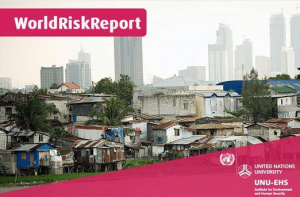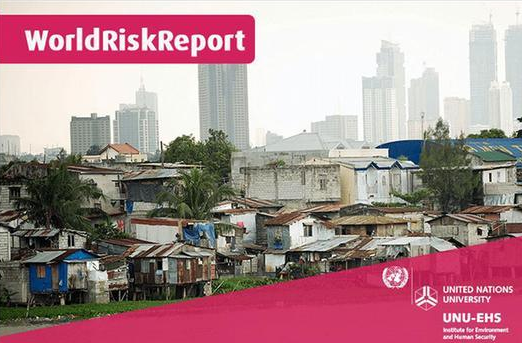The World Risk Report 2016, published by the UNU Institute for Environment and Human Security (UNU-EHS) and Bundnis Entwicklung Hilft, analyses the role that infrastructure plays in shaping a country’s disaster risk. India has been ranked 77th on the World Risk Index, topped by Island state of Vanuatu.
World Risk Index :-
This is a list of countries by natural disaster risk, as measured in the World Risk Index, calculated by the United Nations University for Environment and Human Security (UNU-EHS) and featured in the 2013 World Risk Report (WRR 2013) published by the Alliance Development Works/Bündnis Entwicklung Hilft (BEH).
- The report systematically considers a country’s vulnerability, and its exposure to natural hazards to determine a ranking of countries around the world based on their disaster risk.
- The WRI developed by UNU-EHS and BEH the main feature of the WRR, determines the risk of becoming a victim of a disaster as a result of vulnerability and natural hazards such as earthquakes, storms, floods, droughts and sea level rise for 173 countries worldwide.
- The WRI is based on 28 indicators and research data which are globally freely available and results in a global risk ranking and maps which allow for comparison between countries. Risk is at its highest where a high level of exposure to natural hazards coincides with very vulnerable societies
Measures of Risk Index :-
- The index assessed the risk of disaster in 171 countries through the combined analysis of natural hazards and societal vulnerabilities.
- The Index, calculated by the University of Stuttgart, ranks 171 countries according to their risk of becoming a victim of a disaster as a result of natural hazards such as floods, cyclones, or earthquakes.
- The Island state of Vanuatu has been ranked no 1 on the index. Pakistan ranks 72th while Sri Lanka and Bangladesh at 63rd and 5th position respectively. China and Nepal are in a better position than Indian on 85th and 108th position.
- The international community must invest more in the establishment and development of critical infrastructure even before disasters occur.
- Crumbling transport routes, unreliable electricity grids, and dilapidated buildings not only hinder humanitarian aid from overseas, but also delay crucial aid for those affected in the event of a disaster.
- Inadequate infrastructure and weak logistic chains substantially increase the risk that an extreme natural event will become a disaster.
AffairsCloud Recommends Oliveboard Mock Test
AffairsCloud Ebook - Support Us to Grow
Govt Jobs by Category
Bank Jobs Notification





